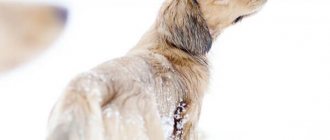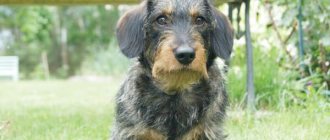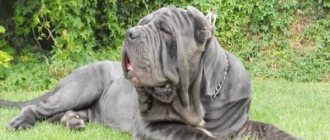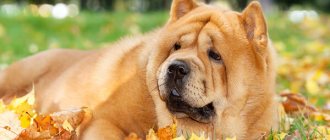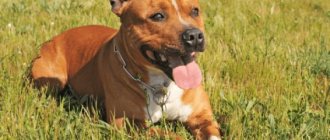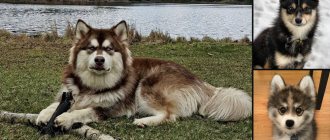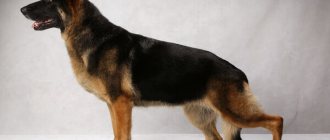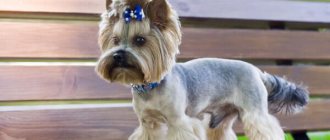The English Toy Terrier is a small, smooth-haired dog that is rarely seen in Russia at dog shows.
This breed is currently considered rare even in its homeland - England, although it was once widespread there.
Outwardly, the English Toy looks more like a miniature Doberman than the Russian Toy, which has long become popular in our country.
These energetic and lively dogs are considered ideal pets and companions.
History of origin
The English Toy Terrier is a descendant of the English Black and Tan Terriers, which in ancient times were used to hunt small game and kill rodents.
Black and tan terriers also took part in exhibition fights with rats. Such entertainment was very popular in Great Britain during the Victorian era. Bets were placed on the little fighters - spectators named the expected number of rats that the dog would deal with in a certain time.
NOTE!
A black and tan terrier named Tiny, whose weight was only 2.5 kg, set a kind of record in 1848 - it dealt with 300 rodents in an hour. For this, the brave little rat catcher was even depicted life-size in a painting by the English artist Thomas Jones Barker
At the end of the 19th century, when rat fighting was banned, but serious breeding work began and the first breed clubs began to appear, these dogs were very popular.
Until 1920, Manchester and Black and Tan Terriers were considered two size varieties of the same breed. The very name “English Toy Terrier” appeared in 1962, and the first official standard was written in 1988.
In America, where the number of black and tan and Manchester terriers brought there back in the 19th century was small, the division into two breeds never happened. Both of these varieties are still considered one breed, now called the Manchester Toy Terrier.
Mating
Full puberty ends in dogs at 2 years of age . At this time, girls begin their third heat. Attentive owners should monitor the course of the female's cycle. Days 13-15 are considered favorable for mating , when signs appear: a loose large loop, transparent or light discharge, playful behavior.
Both male and female must be registered with the breed club (if they have documents and pedigree). The nursery selects pairs that complement each other's shortcomings. The owners fill out documents, agree on the location of the procedure and its cost.
Read a detailed article on the topic: “Everything you need to know about breeding dogs: appropriate age, what to do if it doesn’t work out, rules and tips.”
On the appointed day, the pets are brought together on neutral territory so that the male feels relaxed and the male feels restrained. The dogs get to know each other, sniff, and walk together. If the girl is ready, she will allow you to do the cage. Toys do not vary much in size between the sexes, so you only have to help the first time. You can invite a specialist to solve the problem. If the animals are in the castle, then the mating was a success. But even in the absence of a lock, a girl can become pregnant. Pets are brought again every other day.
The progress of pregnancy can be checked at an ultrasound center. The first signs appear in the 2nd week, but the status can be recorded and clarified only after 20-25 days.
Description of the breed
This is a miniature, smooth-haired dog with a graceful build. It is distinguished by its mobility, impulsive temperament and well-developed hunting instinct, thanks to which English toy terriers still make excellent rat catchers.
In the past, toys were used to hunt rabbits and foxes, but nowadays they are faithful, devoted and selflessly loving companion dogs.
These small dogs are famous for their courage, intelligence and good health. They take root equally well both in a country house and in an apartment.
Norwich Terrier
Soft shaggy dogs were created to get rid of rodents and were used for hunting foxes, but found their purpose in urban environments. The relatively young breed was developed in Norkfolk at the end of the 19th century.
Norfolk Terrier
A smaller copy of the Norwich Terrier, bred in the 60s of the 19th century, is an excellent rat catcher.
The Norkfolk Terrier differs from the Norwich Terrier in the structure of its ears : the Norkfolk has drooping ears, while the Norwich has erect ears.
This is one of the most flexible terriers, a loyal family friend.
Patterdale Terrier
A hunting breed bred in the 60s of the 20th century, it was used in inaccessible mountainous areas. It was widely used in fox hunting, and after its abolition it achieved success in dog sports.
Character traits
The English Toy Terrier is energetic and active. A lively temperament is one of its main breed characteristics, as well as courage, intelligence, intelligence, and friendliness.
This doggie has nothing against being the center of everyone's attention. He loves to be admired and, thanks to his sociability, often becomes the life of the party.
The English Toy Terrier treats strangers with distrust and wariness. Thanks to this, English toys make good watchmen.
He is loyal to other dogs living in the house, but on the street conflicts and even fights are possible, since the toy terrier will not miss the opportunity to bark at someone else’s dog.
He gets along well with children, but only with older ones who are at least 10-11 years old. It is not recommended as a gift for children, as they may accidentally injure the pet.
IMPORTANT!
If there are small animals in the house, such as hamsters, guinea pigs or rabbits, it is necessary to limit their contact with the toy terrier, as he may consider them his potential prey.
It is also better for the toy terrier to communicate less frequently with cats and domestic ferrets, since in this case serious conflicts are possible during which both participants in the fight may suffer.
Advantages and disadvantages of the breed
The undoubted advantages of the breed are:
- aesthetically pleasing appearance;
- ease of maintenance;
- mobility;
- flexibility in learning and training;
- devotion and fidelity;
- can be trained to a tray/diaper.
But there are also disadvantages:
- due to some physiological characteristics, representatives of the breed have a very fragile skeleton and are susceptible to injuries and a number of diseases;
- pets do not tolerate cold well and can freeze even in summer;
- They are wary of unfamiliar people and strangers, so they can show aggression, just like their close relatives - Staffordshire Terriers - towards their relatives.
This dog clearly has more advantages than disadvantages.
Differences from Russian Toy (with examples in the photo)
The English Toy Terrier is a miniature breed - it is larger than the Russian Toy and looks similar not so much to it as to the more athletic Manchester Terrier. The Russian Toy is 20-28 cm tall, while the English Toy is from 25 to 30 cm, and weighs up to 4 kg.
This dog, unlike its smaller relative, which has long become just a companion, has not lost its qualities as a hunter and rat catcher and can even now successfully participate in fox hunts and destroy rodents.
The build of the English Toy is stronger and more muscular, the skull is flatter than that of the Russian Toy Terrier, and the muzzle is longer and wider. The jaws are stronger, the cheekbones are better defined.
The erect ears
of the Russian Toy have the shape of an isosceles triangle, while the English Toy has the shape of a candle flame characteristic of this breed.
The main external differences between these two breeds is the type of coat. If the Russian Toy can be both short-haired and long-haired, then the English Toy can only have a smooth-haired type.
Also, if the Russian Toy Terrier can have a color of black, brown, blue, lilac and tan, as well as fawn or red, then for the English Toy only black and tan color .
NOTE!
English toy terriers are more resistant to stress. They are not characterized by nervousness, excessive barking and disruptions in behavior, as is sometimes the case with Russian Toys.
Prices
It is better to buy a dog in nurseries or from breeders, and carefully study all the documents.
Representatives of this unique breed value:
- miniature size;
- exterior and its features;
- beautiful and rare color;
- wool length;
- character and its features;
- breeder's reputation;
- parents and their titles;
- pedigree.
Bitches, unlike males, are always more expensive.
The most expensive show class puppies. The cost ranges from 40 thousand to 85 thousand rubles. The second price category includes breed-class pets. They cost from 20 thousand to 40 thousand rubles. And the cheapest, but no less beloved and beautiful - representatives of the pet class, the cost of which is from 15 thousand to 30 thousand rubles.*
Before purchasing, you need to make sure that the puppy has:
- brand;
- chip (optional);
- puppy card;
- veterinary passport;
- all necessary vaccinations and a record of deworming.
Adopting a Toy Terrier into your family means finding an excellent friend who is not at all difficult to care for. The main thing is to choose the right puppy from a trusted breeder, so that later the cute puppy does not grow into a mongrel.
*Prices in the article are as of November 2022.
Accepted standard
Height is 25-30 cm, weight on average is from 2.5 to 3 kg, but there are also larger dogs, weighing up to 4 kg.
Description of other standard features:
- the head is wedge-shaped, elongated, with a wide lower jaw and a flattened, elongated skull;
- The eyes are medium-sized, almond-shaped, relatively close-set. The desired color is dark brown, the darker it is, the better;
- the ears are close and high set, erect, having the shape of a candle flame characteristic of these dogs;
- the nose is black;
- the neck is graceful, but not too thin, of medium length;
- the back is short and muscular. The loin is quite strong, merging into a sloping croup;
- the tail is thin, tapering towards the end, medium in length;
- the chest is deep, but not wide, the ribs are slightly compressed from the sides, but at the same time quite convex;
- the belly is tucked up and forms a rather sharp bend, characteristic of this breed;
- the forelimbs are parallel and straight, without signs of weakness or excessive lightness of the bones;
- The hind legs are muscular, with well defined knee joints. The paws resemble those of a cat, with rather thick pads;
- The color is exclusively black and tan.
The English Toy Terrier can only be smooth-haired. Individuals with long hair are considered plembraces.
Expert opinion
Kozhevin Semyon Kirillovich
Expert dog handler.
The English Toy Terrier has a lively and active temperament. They are brave, friendly and loyal animals that truly love their owners. Lack of nervousness is one of the main positive qualities of these dogs. The English Toy does not require complex care; it is quite hardy and in good health. This dog is ideal for living in city apartments and does not need long walks.
Main characteristics
| Breed parameters | |
| Country of origin: | Great Britain |
| Weight of the breed: | males: 2.5-3.5 kg, females: 2.5-3.5 kg |
| Height at withers: | male: 25-31 cm, females: 25-31 cm |
| Temperament: | moderate |
| Wool: | short |
| Role in human life: | companion |
They are ideal companions, loyal and devoted friends. They get along well with children and get along with other pets, however, they require attention, love and care.
Advantages and disadvantages
Pros:
- small compact size;
- smart and quick-witted;
- stress-resistant - they are not characterized by increased nervousness or nervous breakdowns;
- friendly and affectionate towards their owners;
- devotees;
- they make good guards;
- do not require complex care;
- treat other dogs living in the house well, as well as children;
- playful and cheerful;
- They are in good health and live long enough.
Minuses:
- self-willed and stubborn, like all terriers;
- too mobile, sometimes hyperactive;
- it is not always easy to train them;
- show aggression towards other people's dogs, as well as small animals;
- tend to become attached to one person, although they love all family members.
Another disadvantage of English toy terriers is their rarity and high price, which is why it can be difficult to buy a purebred dog of this breed.
Education and training
Decorative toy requires hard training. Otherwise, a small, good-natured terrier puppy can turn into a small but harmful adult dog. Naturally, the methods and approaches of English Toys differ from raising large breed dogs. It is very important to teach energetic children useful commands. The toy terrier must clearly follow the primary commands “fu” and “sit”. In order for a terrier dog to grow up obedient, it is necessary to observe certain conditions when raising it:
- Do not shout during training, speak in an even, calm voice;
- Do not show aggression towards a baby of this breed;
- Diligently and persistently repeat the command until it is strictly carried out.
A common problem: toy terriers are naturally biting and can bite without any aggression. You should never beat dogs, but you definitely need to stop them.
Life expectancy and health
On average, these dogs live 12-13 years, but long-livers are also known, whose age reached 15-20 years.
The English Toy is a relatively healthy breed, but they also have diseases such as:
- glaucoma;
- cataract;
- dislocation of the lens of the eye;
- retinal atrophy;
- hypothyroidism;
- Peters disease.
Due to the fact that the smooth coat does not protect the animal well enough from adverse weather conditions, English Toys are prone to overheating and hypothermia. In addition, a dog of this breed may not tolerate anesthesia well.
Diseases
The life cycle of a dog is 11-13 years. In general, the mini terrier is in good health. However, this breed, like all others, is characterized by special types of pathologies:
- Problems with the musculoskeletal system. Fractures and dislocations can occur from excessive activity of the pet. Often injuries end in surgery.
- Neurological disorders. For example, hydrocephalus (treated with surgery).
- Displacement of the cervical vertebrae. The dog is in severe pain and his limbs cannot move well. The pet's health can only be restored through surgery.
- Anomalies in the digestive tract. Metabolism is disrupted. The dog is lethargic and refuses to eat. It is treated with conservative therapy and surgery.
- Pancreatitis. Symptoms: loose stools, categorical refusal to eat. It is treated with injections and medications.
English Toys have a genetic predisposition to retinal atrophy. Cataracts often occur in adults.
How to care?
The English Toy Terrier should live only in a house or apartment - yard and aviary keeping is not suitable for it.
Caring for it is not difficult. It is recommended to comb the coat 2 times a week with a mitten to care for smooth-haired dogs. Such a dog should be washed only when necessary. Eyes, ears and teeth should be examined every day, but brushing should not be done unless necessary. The nails are shortened approximately once a month in an adult animal, and once every 15-20 days in a puppy.
The Toy Terrier gets cold easily, and therefore this dog cannot do without weather-appropriate clothing.
Care and maintenance
Toys themselves are small and smooth-haired, which makes street keeping almost impossible. If the climate is warm and dry, then free walking in the local area is allowed. Typically, such pets become domestic sofa dogs. They do not require special care or special cosmetic procedures, so they rarely cause problems for their owners.
Before buying a puppy, you need to arrange a place for it. Low bowls, a comfortable bed, toys, and brushes are purchased. You will need winter clothes.
Nutrition
Little Toys do not have any special dietary indications. Despite their size, dogs have a good appetite, so it is important to accustom your puppy to a certain amount of food. Usually, Terriers need 200-400 grams of food per day. Up to 4 months it is divided into 4-5 parts , during the period of 5-8 months - into 3 parts . By the age of one year, the pet should receive food twice (morning and evening).
The kennel will give recommendations on feeding the dog. But the owner will still have a choice between dry and natural food. It is necessary to transfer from one type to another carefully, feeding with new products.
Ready-made dry products are convenient for dog owners . Firstly, they do not need to be heated or boiled, and secondly, they are convenient to pour and store. They also contain a vitamin complex, which makes it easier to introduce additional bait. When choosing a brand, you should rely on your specific pet and its preferences. Toy terriers are small, they need a super-premium holistic product for small breeds (with medium-sized granules). You can choose a line for a sick pet or a special food for a pregnant female.
Natural nutrition has always been considered healthy, but only in the case of a properly selected menu. If the owner himself chooses the products and prepares them, then the chance that something unhealthy or stale will come across is small.
- The diet must include processed or fresh meat (lamb, rabbit, turkey) approximately 30% of the daily menu.
- In addition to the meat component, you need to introduce other proteins - eggs, kefir, cottage cheese.
- For carbohydrates , dogs are given boiled cereals (buckwheat, oatmeal and rice), raw vegetables and fruits (carrots, apples, beets).
It is strictly forbidden to feed the puppy human food. There is a strict taboo on sweet and floury, fatty and fried, salty and smoked foods. The diet should not contain potatoes, legumes, wheat, sugar, pork and chicken, bones, or citrus fruits.
Only sea fish, frozen or boiled are allowed. It is recommended to scald the meat with boiling water. Be sure to introduce vitamin supplements (brewer's yeast, eggshells, vitamin tablets).
We recommend that you read a detailed article on the topic: “How and what to feed a dog: types and characteristics of nutrition.”
Drinking regime is important, especially when the pet is sick. If the puppy does not drink on his own, he is desoldered from a syringe (without a needle). The drinking bowl must be filled with clean water daily. After each meal, bowls are washed under hot water (without chemicals).
Health
Toys cannot boast of ideal good health. They are quite fragile, often injured, and do not tolerate heat and frost well. Due to unstable selection, animals have acquired several stable genetic diseases. On average, English Terriers live 10-13 years . Owners can prevent the occurrence of certain infectious diseases through vaccination.
Vaccinations
Vaccination is the only reliable way to prevent infection with infectious diseases. Even a pet that is not walked or introduced to other dogs can contract the virus from a person. People carry thousands of bacteria on their clothes and shoes, and not all of them are beneficial to living organisms.
There are 2 required vaccinations:
- A complex vaccine containing strains of distemper, parvovirus, hepatitis, influenza, leptospirosis is carried out at 2, 2.5, 6, 12 months and repeated every year ;
- The rabies vaccine is given at 7 months and repeated once every 2 years (maybe more often, depending on the drug).
Two weeks before the procedure, the dog must be dewormed. On the day of vaccination, the dog must be absolutely healthy. This is checked by measuring the temperature; if there is a deviation from the norm, vaccination is not carried out. Malnourished pets and pregnant females are not allowed to be vaccinated.
Vaccination is carried out in a veterinary clinic. Some dog owners prefer to administer the injection themselves. This is possible only if you are completely sure that there are no allergies to the components.
Important article on the topic: “Everything you need to know about dog vaccinations.”
Diseases
Toys are prone to some genetic diseases transmitted from their parents:
- Peters disease (destruction of the femoral head, causing lameness, severe pain);
- Cataracts, glaucoma, other eye problems;
- Hypothyroidism (underactive thyroid gland);
- Diabetes;
- Brittle teeth (manifests at the age of 6-10 years).
Owners need to pay attention to the health of the parents and take into account their problematic aspects. It is worth remembering that Toys are very fragile. It is important to avoid overloading the limbs, falls, and impacts.
Walk
Walk pets 2 times a day. Some owners transfer their dogs to full housekeeping, that is, to a litter tray. This is convenient, but brings a lot of stress to the dog. It is important for an animal to express its activity and meet new people and pets.
They begin to take Toev outside after the second vaccination. At first they are carried out in their arms (2-3 days), then lowered to the ground. Up to 3 months, the Terrier is walked 3-4 times for 30 minutes . Then they are accustomed to walking twice a day for 40-60 minutes .
Despite their modest size, English Toys need a lot of running and exercise. They will not be against morning jogging, sports games for dogs (freestyle, agility).
Grooming
The breed is easy to care for and does not require special procedures. It is enough to iron the wool with a special glove 2 times a week, and when shedding - 3-4 times . Toys are bathed only in case of severe contamination, but not more than 2 times a year. You need to wipe your paws after every walk.
From childhood, the pet is taught to brush its teeth (2 times a week) and examine its ears and eyes (daily). Nails are trimmed once every 3-4 weeks . It is also important to treat Terriers for fleas and worms once a trimester . In the warm season, it is recommended to strengthen protection against ectoparasites.
How to train correctly?
Due to the fact that English toy terriers can be quite stubborn and headstrong, you need to start raising and training your pet as early as possible - literally from the day you acquire it.
Dogs of this breed are smart and quick-witted and, as a rule, remember new commands well. But they do not always do them, but only when there are no other, more interesting things to do.
That is why it is so important to achieve impeccable obedience from the toy, because otherwise you may not be able to cope with your pet in a critical situation when, for example, he runs out onto the highway chasing a cat.
IMPORTANT!
When raising and training an English Toy Terrier, you cannot yell at him or punish him unfairly. This will only make the dog even more stubborn. In addition, this can greatly frighten the puppy and even ruin his psyche.
Caring for puppies
The puppy will need a comfortable sleeping place and separate dishes. You should take care of toys, special tongs for shortening nails, a combing mitt and special shampoo for smooth-haired dogs.
An English Toy in a new home is first fed the food that he is accustomed to while living in a kennel: natural food or ready-made food. If the owner decides to change the type of food, this should be done gradually, over two weeks.
Puppies of this breed are fed at the following frequency:
- 2-3 months - 5-6 times a day;
- from 4 months to six months – 4 times;
- from 6 months to a year – 3 times.
Products are introduced into the diet gradually, each new type of food over two to three days. First, English Toychiks are accustomed to milk and milk porridge. Next to the finely chopped meat.
At 3 months they give boiled sea fish, at 4 months - offal. At 6 months the diet is similar to that of an adult dog
How to feed?
You can feed your toy terrier either ready-made premium food or higher, or prepare homemade food for it.
It is very important that the diet is balanced and the portions are correct. You should not underfeed or overfeed your dog, as this can lead to problems with its health.
You cannot feed your English Toy low-quality, cheap food with dyes and preservatives, as well as stale or poor-quality homemade food.
If the dog eats natural food, then the basis of his diet should be protein products of animal origin - meat, meat products, dairy products, to which you need to add a little porridge or vegetables.
If desired, you can treat your toy terrier with seasonal fruits or a piece of low-fat hard cheese.
Feeding
A dog's complete diet should include meat: rabbit, chicken or beef. Pork should be excluded from the diet. Give your baby bones - to train the jaws, raw vegetables, fresh fruits, cottage cheese - to strengthen teeth, vitaminize the body. Food in the form of canned food and dry food is allowed, but in small doses.
How to choose a puppy?
Finding a purebred puppy is not easy even in England, not to mention Russia.
However, more and more often you can see advertisements on the Internet or in the press about the sale of puppies supposedly of this breed for 3-10 thousand rubles without documents.
Most often, ordinary Russian black and tan toy terriers, miniature pinschers with undocked tails, or even just mixed breeds and small smooth-haired mongrels are sold under the guise of Englishmen. Often, even the color of the dogs sold has nothing in common with the standard one - fawn, red, brown and tan puppies are sold under the guise of English toy terriers.
NOTE!
In order not to purchase a dog that has nothing in common with the desired breed, the pet should be purchased only from a specialized nursery. In this case, the puppy must have a metric, and its parents must have pedigrees.
You should also remember that a puppy of a rare breed cannot be cheap, but if you really want to buy an English Toy, then it is better not to save on buying a pet.
Fox terrier
Smooth-haired type
Another avid hunter, it was used to hunt foxes, badgers, and raccoon dogs. There are also wire-haired foxes, but smooth-haired ones are considered a classic variation of the breed type. The dogs are temperamental and suitable for people leading an active lifestyle.
Wire-haired type
It was used for fox hunting - a nimble dog climbed into a fox hole, grabbed the prey, and the hunter pulled it out by the tail. He showed himself excellent in agility and other dog sports.
